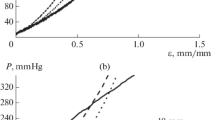Abstract
There is considerable evidence that the localization and evolution of vascular disease are mediated, at least in part, by mechanical factors. The mechanical environment of the coronary arteries, which are tethered to the beating heart, is influenced by cardiac motion; the motion of the vessels must be described quantitatively to characterize fully the mechanical forces acting on and in the vessel wall. Several techniques that have been used to characterize coronary artery dynamics from biplane cineangiograms are described and illustrated. There is considerable variability in dynamic geometric parameters from site to site along a vessel, between the right and left anterior descending arteries, and among individuals, consistent with the hypotheses that variations in stresses mediated by geometry and dynamics affect the localization of atherosclerosis and individual risk of coronary heart disease. The few frankly atherosclerotic vessels that have been examined exhibit high torsions in the neighborhood of lesions, an observation which may have etiologic or diagnostic implications. © 2002 Biomedical Engineering Society.
PAC2002: 8759Dj, 8757Gg, 8719Uv, 8719Hh
Similar content being viewed by others
REFERENCES
Caro, C. G., J. M. Fitzgerald, and R. C. Schroter. Arterial wall shear and distribution of early atheroma in man. Nature (London) 223:1159–1161, 1969.
Coatrieux, J. L., M. Garreau, R. Collorec, and C. Roux. Computer vision approaches for the three-dimensional reconstruction of coronary arteries: Review and prospects. Crit. Rev. Biomed. Eng. 22:1–38, 1994.
Delfino, A., N. Stergiopulos, J. E. Moore, Jr., and J. J. Meister. Residual strain effects on the stress field in a thick-wall finite-element model of the human carotid bifurcation. J. Biomech. 30:777–786, 1997.
Ding, Z., T. Biggs, W. A. Seed, and M. H. Friedman. Influence of the geometry of the left main coronary artery bifurcation on the distribution of sudanophilia in the daughter vessels. Arterio. Thromb. Vasc. Biol. 17:1356–1360, 1997.
Ding, Z., and M. H. Friedman. Dynamics of human coronary arterial motion and its potential role in coronary atherogenesis. J. Biomech. Eng. 122:488–492, 2000.
Ding, Z., and M. H. Friedman. Quantification of 3D coronary arterial motion using clinical biplane cineangiograms. Int. J. Cardiac Imaging 16:331–346, 2000.
Friedman, M. H., O. J. Deters, F. F. Mark, C. B. Bargeron, and G. M. Hutchins. Arterial geometry affects hemodynamics. A potential risk factor for atherosclerosis. Atherosclerosis (Berlin) 46:225–231, 1983.
Friedman, M. H., and Z. Ding. Relation between the structural asymmetry of coronary branch vessels and the angle at their origin. J. Biomech. 31:273–278, 1998.
Friedman, M. H., Z. Ding, G. M. Eaton, and W. A. Seed. Relationship between the dynamics of coronary arteries and coronary atherosclerosis. Proceedings of the Summer Bioengineering Conference, Big Sky, MT, 16-20 June 1999, pp. 49–50.
Fry, D. L. Acute vascular endothelial changes associated with increased blood velocity gradients. Circ. Res. 22:165–197, 1968.
Fung, Y. C. Biomechanics: Circulation, 2nd ed. New York: Springer, 1996.
Gross, M. F., and M. H. Friedman. Dynamics of coronary artery curvature obtained from biplane cineangiograms. J. Biomech. 31:479–484, 1998.
Guggenheim, N., P. A. Doriot, P. A. Dorsaz, P. Descouts, and W. Rutishauser. Spatial reconstruction of coronary arteries from angiographic images. Phys. Med. Biol. 36:99–110, 1991.
Hofman, M. B. M., S. A. Wickline, and C. H. Lorenz. Quantification of in-plane motion of the coronary arteries during the cardiac cycle: Implications for acquisition window duration for MR flow quantification. J. Magn. Reson. Imaging 8:568–576, 1998.
Kass, M., A. Witkin, and D. Terzopoulos. Snakes: Active contour models. Int. J. Comput. Vis. 1:321–331, 1988.
Kong, Y., J. J. Morris, and H. D. McIntosh. Assessment of regional myocardial performance from biplane coronary cineangiograms. Am. J. Cardiol. 27:529–537, 1971.
Lengyel, J., D. P. Greenberg, and R. Popp. Time-dependent three-dimensional intravascular ultrasound. Proceedings of the ACM SIGGRAPH Conference on Computer Graphics, Los Angeles, CA, 6-11 August 1995, pp. 457–464.
Makey, S. A., M. J. Potel, and J. M. Rubin. Graphical methods for tracking three-dimensional heart wall motion. Comput. Biomed. Res. 15:455–473, 1982.
Moore, J. E., Jr., N. Guggenheim, A. Delfino, P. A. Doriot, P. A. Dorsaz, W. Rutishauser, and J. J. Meister. Preliminary analysis of the effects of blood vessel movement on the blood flow patterns in the coronary arteries. J. Biomech. Eng. 116:302–306, 1994.
Nerem, R. M. Vascular fluid mechanics, the arterial wall, and atherosclerosis. J. Biomech. Eng. 114:274–282, 1992.
Pao, Y. C., J. T. Lu, and E. L. Ritman. Bending and twisting 428 DING et al. of an in vivo coronary artery at a bifurcation. J. Biomech. 25:287–295, 1992.
Potel, M. J., J. M. Rubin, S. A. Mackay, A. M. Aisen, J. Al-Sadir and R. E. Sayre. Methods for evaluating cardiac wall motion in three dimensions using bifurcation points of the coronary arterial tree. Invest. Radiol. 18:47–57, 1983.
Puentes, J., C. Roux, M. Garreau, and J. L. Coatrieux. Dynamic feature extraction of coronary artery motion using DSA image sequences. IEEE Trans. Med. Imaging 17:857–871, 1998.
Ritman, E. L., J. H. Kinsey, R. A. Robb, B. K. Gilbert, L. D. Harris, and E. H. Wood. Three-dimensional imaging of heart, lung, and circulation. Science 210:273–280, 1980.
Ruan, S., A. Bruno, and J. L. Coatrieux. Three-dimensional motion and reconstruction of coronary arteries from biplane cineangiography. Image Vision Comput. 12:683–689, 1994.
Stevenson, D. J., I. D. R. Smith, and G. Robinson. Working towards the automated detection of blood vessels in x-ray angiograms. Pattern Recogn. Lett. 20: 6, 1987.
Thubrikar, M. J., S. K. Roskelley, and R. T. Eppink. Study of stress concentration in the walls of the bovine coronary arterial branch. J. Biomech. 23:15–26, 1990.
Author information
Authors and Affiliations
Rights and permissions
About this article
Cite this article
Ding, Z., Zhu, H. & Friedman, M.H. Coronary Artery Dynamics In Vivo . Annals of Biomedical Engineering 30, 419–429 (2002). https://doi.org/10.1114/1.1467925
Issue Date:
DOI: https://doi.org/10.1114/1.1467925




